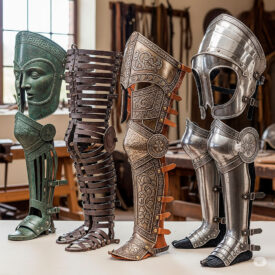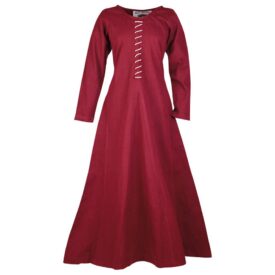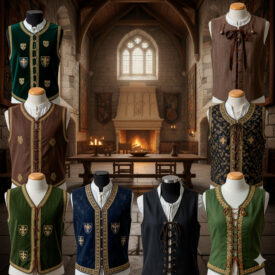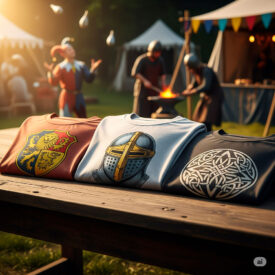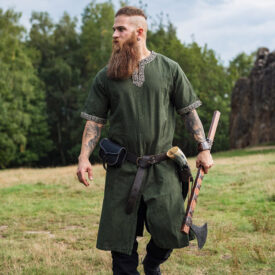The Middle Ages, a fascinating period spanning a thousand years of history, left us a very rich cultural legacy, and its fashion is no exception. When we think of medieval dress, we often picture gleaming armor, long tunics or sumptuous gowns, but there is a fundamental garment that supported the entire outfit, for both nobles and commoners: the medieval shirt.
Far from being a simple piece of cloth, the shirt was an essential component of everyday life and a reflection of the society of its time. Its evolution tells a story of technological advances, social structures and cultural values.
Beyond Appearance: What Was a Medieval Shirt?
In the Middle Ages, the shirt, often known as an undergarment, was the base layer of dress. It was worn directly against the skin and served vital functions:
- Skin protection: It prevented direct contact with outer fabrics that were often coarser or rougher.
- Thermal regulation: It helped keep the body warm in winter and cool in summer thanks to its absorbent properties.
- Hygiene: It absorbed sweat and bodily moisture, protecting the more valuable outer layers from dirt and wear.
Terminology could vary regionally (such as ‘chemise’, ‘cotte’ or ‘under-tunic’), but its main purpose was always the same. It is important to note that, historically, shirts as we know them today—with more defined cuts and worn as outer garments—began to gain popularity toward the end of the Middle Ages, especially when trousers became tighter and blouses shorter. They became indispensable during the Renaissance. Before that, tunics dominated the upper body.
Shirts and blouses are garments, either formal or informal, made of fabric that cover the torso and usually have a collar, sleeves and front buttons.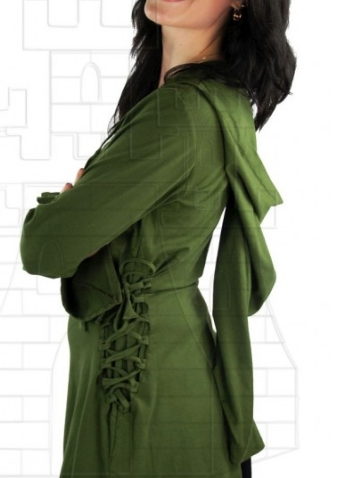
The word ‘shirt’ comes from the Arabic qamis, which derives from the Latin camisia. The history of the shirt can be traced back to 1500 BC, when the Egyptians, both men and women, adopted the kalasiris, a rectangular piece of thin linen with an opening to put the head through. This basic garment laid the groundwork for what, centuries later, would evolve into the medieval shirt we know. Its simplicity and functionality allowed it to endure across different cultures and historical periods.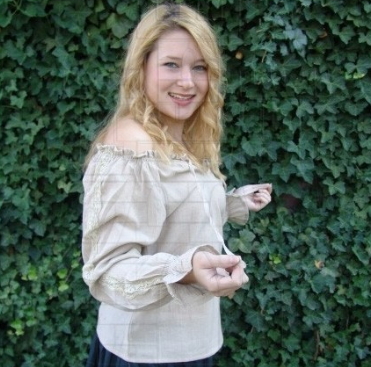
The Evolution of Dress: From Tunic to Shirt
Medieval fashion was not static; it changed and adapted over the centuries, reflecting not only aesthetic trends but also advances in tailoring techniques and the practical needs of society.
Early Middle Ages (c. 500–1000 AD): Functional Simplicity
During this period, clothing was predominantly simple and functional. Men typically wore short tunics reaching the knees, paired with hose to cover the legs. Garments were loose, made mainly from rectangular pieces of fabric, and adjusted to the body with belts. The shirt, at this stage, was indistinguishable from an under-tunic, serving as the first layer of protection and comfort.
High Middle Ages (c. 1000–1250 AD): Toward Sophistication
Over time, tunics began to lengthen, reaching the ankles. This change marked a trend toward more formal, structured dress. Thanks to improvements in tailoring techniques, clothing started to fit the body more closely, allowing for more defined and elegant silhouettes. The shirt, although still an undergarment, began to differ subtly in cut and construction from outer tunics.
Late Middle Ages (c. 1250–1500 AD): The Rise of Tailoring
The Late Middle Ages was a period of great innovation in fashion. Clothing became more elaborate and fitted, creating a clear distinction between inner and outer layers. Doublets (fitted upper garments) and tight hose became popular, which led the shirt, while still an undergarment, to adopt clearer cuts. It could feature puffed sleeves gathered at the cuffs or be shaped with lacing. Traditional shirts remained loose, with wide sleeves and a full skirt reaching mid-thigh. Another late-period variant was more fitted and short, sometimes with a pointed front covering the groin and tightened with side or back lacing.
During the Roman Empire, sleeves were added to that piece of cloth, creating the tunica manicata. In the Middle Ages and until the 14th century, the shirt was a white undergarment whose function was to protect the skin from rougher outer fabrics. Considered underwear, it lacked buttons to close it and served to cover the body before putting on the jerkin or sweater. This barrier function between the skin and outer garments was crucial for hygiene and the preservation of more expensive clothing.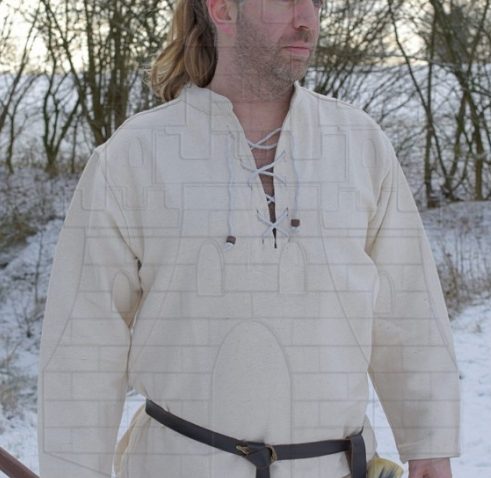
The widespread use of shirts in the 14th century, together with increased linen production and its eventual disposal, made enough old shirt rags available to manufacture paper at low cost. The invention of the printing press, combined with inexpensive paper, helped the book emerge as an affordable product rather than an old curiosity reserved for a few. This underlines how an apparently humble garment like the medieval shirt had an indirect but significant impact on the spread of knowledge and culture.
It was during the Renaissance that the shirt became common as a visible and stylistic element, transcending its role as mere underwear. Italian fashion of the time widened the sleeves so that part of them showed at the elbows, creating an effect of volume and elegance. This marked the start of the shirt as a piece with its own aesthetic value.
Later, the Germans adopted the slashed style—a fashion originating in Switzerland that involved cutting the outer garments to reveal the fabric beneath, thereby showing the inner shirt. This detail, which seems bold today, was a fashion statement at the time, displaying the richness of the inner textiles. In the 16th century, square necklines were introduced, adding another dimension to shirt design.
During and after the French Revolution, toward the end of the 18th century, men’s clothing changed significantly. Cleaner lines, characteristic of English dress, appeared, leading to the loss of previous ornamentation and the beginning of the shirt as we know it today: an essential, versatile outer garment.
Materials: A Reflection of Status and Daily Life
The materials used to make medieval shirts were a clear indicator of the wearer’s social position, as well as of resource availability and textile technology of the time. The choice of fabric affected not only comfort and durability but also status and the garment’s overall appearance.
Linen: King of Undergarments
Linen was undoubtedly the most common and versatile material for shirts. Its production was laborious—from cultivating flax to spinning and weaving—but the result was a strong, durable fiber very pleasant to the touch. It was ideal for undergarments due to its ability to absorb moisture and dry quickly, making it perfect for personal hygiene in an era when bathing was not a daily habit.
- Qualities: Linen quality varied greatly, from coarse, heavy linen suitable for work clothes of peasants and artisans to fine, nearly transparent fabrics of astonishing delicacy reserved for luxury garments only the wealthiest could afford. The fineness of the weave was an unmistakable sign of wealth and distinction.
- Natural color: It was often used unbleached, giving it a natural grayish or brownish tone. Bleached linen, which required extra washing and sun exposure, was a subtle but clear symbol of status and the ability to keep clothing clean and well maintained.
Wool: Warmth in Inner Layers
Although linen dominated for garments in direct contact with the skin, wool was also used, especially in colder regions or for inner layers that provided extra insulation. Wool offered superior warmth and was relatively water-resistant, which made it valuable in harsh climates. Its quality varied widely, from coarse, rough wools for the common people to fine, soft cloths for the elite, often imported from regions with high-quality wool production.
Silk and Cotton: Imported Luxury
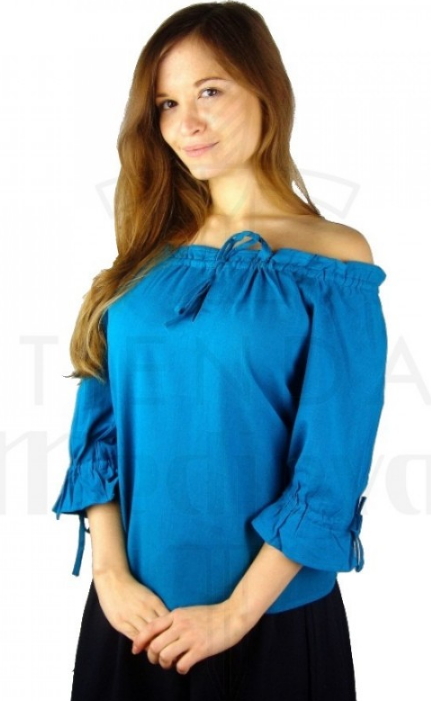 For high nobility and the very wealthy, fine silk shirts were not uncommon. Silk, coming from the Far East via the Silk Road, was an extremely valuable luxury material, a symbol of opulence and exoticism. Its sheen, softness and lightness made it the preferred choice for ceremonial and formal garments.
For high nobility and the very wealthy, fine silk shirts were not uncommon. Silk, coming from the Far East via the Silk Road, was an extremely valuable luxury material, a symbol of opulence and exoticism. Its sheen, softness and lightness made it the preferred choice for ceremonial and formal garments.
Cotton also gained importance toward the end of the Middle Ages, especially in warmer areas, though it remained more expensive and scarce than linen for most of Europe. Its softness and absorbency made it desirable, but its high import cost limited its use to wealthier classes.
Colors and Symbolism: The Medieval Palette
Contrary to popular perception, medieval clothing was not limited to dark or earthy tones. Colors carried deep social and symbolic meanings, and their choice was not random but reflected status, profession, morality and even political or religious affiliation.
- Natural dyes: Colors were obtained from a wide variety of natural sources: plants (such as weld for yellow, madder for red, indigo or woad for blue), animals (such as cochineal for crimson) and minerals. The dyeing process was complex, required specialized knowledge, and significantly increased a garment’s value, making vibrant colors a luxury.
- Status: The higher the social status, the more vibrant and costly the clothing tended to be. The brightest, most durable dyes were the most expensive, so only the nobility and wealthy merchants could afford them.
- Common colors and their meanings:
- White/Ecru: Symbolized purity, innocence and cleanliness. It was very common for shirts as undergarments, since whiteness—or the lack of dye—was a sign of good reputation and personal care. A clean, well-kept white shirt was a badge of decency.
- Blue: A color associated with royalty, nobility and divinity (especially the Virgin Mary). It symbolized loyalty, constancy and truth. Deep blues were particularly valuable.
- Red: Represented power, strength, passion, love and sometimes danger or war. It was popular among the nobility, wealthy citizens and high-ranking clergy. Crimson, obtained from cochineal, was one of the most expensive dyes.
- Green: Associated with nature, youth, hope and fertility. It could also symbolize the richness of the land. It was common among merchants and the middle class.
- Black: Initially associated with mourning and humility, it evolved in the Late Middle Ages to symbolize elegance, sophistication and wealth, especially in Burgundian courts. Deep, durable black dyes were difficult to obtain and therefore very costly.
- Gray and Brown: Were the most common colors for the general population, as they were easier to produce with local dyes and less likely to show dirt, making them practical for daily life and work.
- Sumptuary laws: To maintain hierarchical order and curb excessive luxury, sumptuary laws regulated which colors, materials and types of ornamentation different social classes could wear. These laws dictated, for example, that only the nobility could wear silk or certain vibrant colors, while commoners were restricted to wool and linen in more sober tones.
The shirt models you can find in our shop
If you want variety, quality and good prices, without a doubt our online shop offers all available medieval shirts made from the best materials and ready to wear.
Medieval shirts for men
Medieval blouses for women
Patterns and Design: Functionality and Style
Although seemingly simple at first glance, the design of medieval shirts was the result of careful craftsmanship and continuous evolution, adapting to practical needs and fashion trends. Functionality was paramount, but style and ornamentation also played important roles, especially as the Middle Ages progressed.
- T-shaped cut: The most common basis for making shirts was the T-shaped cut. This design used rectangular pieces of fabric for the body and sleeves, maximizing freedom of movement and optimizing material use, minimizing waste in an era when cloth was precious. Gussets (triangular or square fabric inserts) were often added under the arms for comfort and durability.
- Sleeves: Sleeves could vary greatly. In the Early and High Middle Ages they tended to be wide and straight. By the Late Middle Ages they became more elaborate, sometimes puffed at the top and tighter at the forearm, with cuffs covering the wrist. Often, sleeves were set in separately to the body, allowing greater flexibility in design and fit.
- Necklines: Necklines were usually simple, rounded or with a vertical slit closed by lacing. Sometimes a style called the “amigaut” was used— a wider neckline that could be gathered or adjusted. The simplicity of the neckline reflected the shirt’s role as an undergarment.
- Fitting: Later shirts, especially toward the end of the Late Middle Ages, could include darts or strategically placed panels to achieve a closer fit, following the general fashion trend toward more tailored silhouettes. The introduction of buttons and lacing, though less common than on outer garments, allowed for closer-fitting, figure-enhancing pieces.
- Reinforcements and openings: Despite ornamentation and evolving style, functionality remained key. High-wear areas—such as the collar, cuffs and underarms—were reinforced to extend garment life. Strategic openings, often at the neck or sides, were used to make dressing and undressing easier, especially when outer garments were tight.
- Ornaments: Decorations ranged from simple carefully sewn hems to elaborate embroidery. These were applied to visible areas like the collar, cuffs and hem—parts of the shirt that often peeked out from under outer garments. Such embellishments, along with fine fabric and white linen, were clear signals of wealth, taste and social status. Embroidery could include geometric, floral or even heraldic motifs for nobility.
The shirt in daily life and its social meaning
The shirt was omnipresent in medieval life, a daily-use garment whose importance went beyond mere clothing. Its hygiene, durability and the care it received were crucial aspects that reflected not only practicality but also status and social values.
Hygiene and care: a constant challenge
Cleanliness was a considerable challenge in the Middle Ages, given limited resources and technology. Shirts, being the layer closest to the skin, absorbed sweat and dirt, making them the focus of hygiene practices. They were washed regularly in rivers or streams using lye (an alkaline solution obtained from wood ashes) and bleached in the sun to maintain whiteness. Caring for white shirts, in particular, was a sign of decency, cleanliness and good reputation. A clean, well-maintained shirt was a silent statement about a person’s character and social standing.
Durability and repair: the garment’s value
In an era when clothing was valuable and its production laborious, garments were made to last. Shirts were constantly repaired and patched to extend their useful life. Reinforcing high-wear areas like cuffs, collars and underarms was common practice. Repairs were not only functional; they were often executed artistically, with patches and stitches that, rather than hiding damage, became part of the garment’s design, showing the skill of the tailor or the household member who cared for it. This “repair rather than discard” culture contrasts sharply with today’s fast-fashion mentality.
Changing clothes: an indicator of status
How often one changed shirts depended directly on social status and wealth. Wealthy households and the nobility could afford to change shirts daily or even several times a day, while humbler classes often wore the same shirt for days or even weeks due to garment scarcity and the difficulty of washing. This simple act of changing a shirt was a visible marker of prosperity and access to resources.
Symbolism and deeper meaning
Beyond practical function, the shirt carried deep symbolism. As a garment in direct contact with the skin, it represented purity, innocence and intimacy. The white color of many shirts reinforced this association with physical cleanliness and moral integrity. In courtly settings, a fine, well-kept shirt, sometimes slightly visible beneath outer garments, was a symbol of refinement, sophistication and good taste. It formed the base of one’s public image, even if only a small part was visible.
The medieval shirt today: reenactment and learning
For history enthusiasts, historical reenactment and LARP (live action role-playing), the medieval shirt is a foundational piece. Understanding authentic materials, cutting patterns and sewing techniques allows reenactors and artists to create convincing costumes that transport them through time. This interest has sparked a revival of traditional crafts, helping preserve important cultural skills and the study of medieval daily life.
Ultimately, the medieval shirt is much more than a garment. It is a witness to time, a canvas on which stories of status, culture and personal identity were woven. Studying it allows us to look beyond the surface and understand the rich complexity of life in the Middle Ages—from textile innovations to social norms and hygiene practices. Although often hidden, it was the pillar of dress and a silent reflection of the society that created it.
If you are passionate about history and authentic period clothing, we invite you to explore our collection. You will find everything from medieval blouses for women with period-inspired designs to medieval shirts for men made with attention to detail and materials that evoke the essence of those centuries. Immerse yourself in history and find the perfect piece for your medieval outfit or to add a historical touch to your wardrobe. Discover all our medieval clothing for men, women and children and live history.



